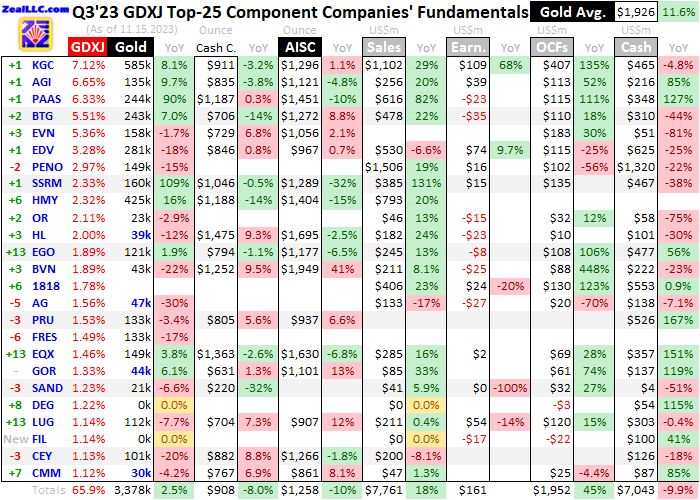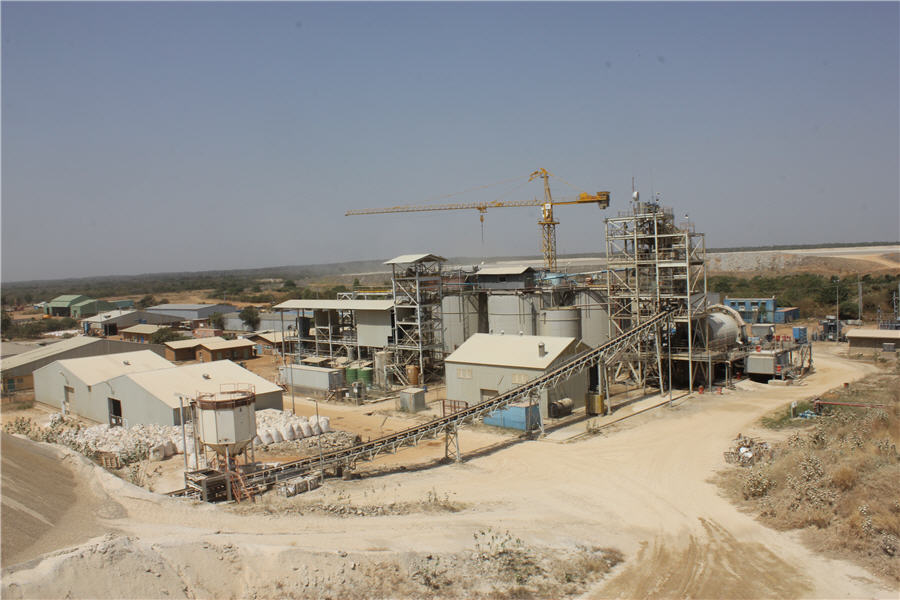Gold mid-tiers’ Q3 2023 fundamentals

The mid-tier and junior gold miners recently finished reporting their latest quarterly results. These smaller producers are fundamentally-superior, in the sweet spot for upside potential in major gold uplegs. Indeed their Q3’23 operational and financial results proved spectacular, much better than their larger peers. The potent combination of lower mining costs and higher gold prices fueled huge profits growth for these companies.
The leading mid-tier-gold-stock benchmark is the GDXJ VanEck Junior Gold Miners ETF. With $4.4b in net assets mid-week, it remains the second-largest gold-stock ETF after its big brother GDX. That is dominated by far-larger major gold miners, although there is much overlap between these ETFs’ holdings. Still misleadingly named, GDXJ is overwhelmingly a mid-tier gold-stock ETF with little weighting allocated to juniors.
Gold-stock tiers are defined by miners’ annual production rates in ounces of gold. Small juniors have little sub-300k outputs, medium mid-tiers run 300k to 1,000k, large majors yield over 1,000k, and huge super-majors operate at vast scales exceeding 2,000k. Translated into quarterly terms, these thresholds shake out under 75k, 75k to 250k, 250k+, and 500k+. Only four of GDXJ’s 25 biggest holdings are true juniors!
Their Q3 production is highlighted in blue in the table below. Juniors not only mine less than 75k ounces per quarter, but their gold output generates over half their quarterly revenues. That excludes both primary silver miners producing byproduct gold, and royalty and streaming companies that purchase future gold output for big upfront payments used to finance mine builds. But mid-tiers often make better investments.
These gold miners dominating GDXJ offer a unique mix of sizable diversified production, excellent output-growth potential, and smaller market capitalizations ideal for outsized gains. Mid-tiers are less risky than juniors, while amplifying gold uplegs much more than majors. Our newsletter trading books are now filled with fundamentally-superior mid-tiers and juniors, smaller gold miners which we’ve long specialized in at Zeal.
While gains are mounting in these high-potential gold stocks, they remain really out of favor. GDXJ has had a wild ride over the past year or so. From late September 2022 to mid-April, GDXJ powered 66.9% higher in a strong upleg! But then the mid-tiers started grinding lower on balance with their metal, and GDXJ fell 29.3% into early October. That recent selloff rebalanced sentiment, eliminating most bullishness.
Since then GDXJ has started clawing back, up 24.1% at best as of late November. Gold-stock uplegs parallel and amplify gold’s, but often start out slower. Traders remain skeptical after major gold selloffs, not convinced of young uplegs’ staying power. But the longer and higher gold runs, the more speculators and investors grow bullish on its potential. So they increasingly flood into gold stocks as gold uplegs mature.
For 30 quarters in a row now, I’ve painstakingly analyzed the latest operational and financial results from GDXJ’s 25-largest component stocks. Mostly mid-tiers, they now account for 65.9% of this ETF’s total weighting. While digging through quarterlies is a ton of work, understanding smaller gold miners’ latest fundamentals really cuts through the obscuring sentiment fogs shrouding this sector. This research is essential.
This table summarizes the GDXJ top 25’s operational and financial highlights during Q3’23. These gold miners’ stock symbols aren’t all US listings, and are preceded by their rankings changes within GDXJ over this past year. The shuffling in their ETF weightings reflects shifting market caps, which reveal both outperformers and underperformers since Q3’22. Those symbols are followed by their recent GDXJ weightings.
Next comes these gold miners’ Q3’23 production in ounces, along with their year-over-year changes from the comparable Q3’22. Output is the lifeblood of this industry, with investors generally prizing production growth above everything else. After are the costs of wresting that gold from the bowels of the earth in per-ounce terms, both cash costs and all-in sustaining costs. The latter help illuminate miners’ profitability.
That’s followed by a bunch of hard accounting data reported to securities regulators, quarterly revenues, earnings, operating cash flows, and resulting cash treasuries. Blank data fields mean companies hadn’t disclosed that particular data as of mid-November. The annual changes aren’t included if they would be misleading, like comparing negative numbers or data shifting from positive to negative or vice-versa.
The mid-tier gold miners’ overall Q3’23 performance proved spectacular! These sweet-spot-for-upside smaller gold stocks grew their production while slashing mining costs. That along with surging prevailing gold prices fueled massive earnings jumps, both per ounce and absolutely. Last quarter was undoubtedly one of the best the mid-tier and junior gold stocks ever reported, which should really attract back investors.

Production growth trumps everything else as the primary mission for gold miners. Higher outputs boost operating cash flows which help fund mine expansions, builds, and purchases, fueling virtuous circles of growth. Mining more gold also raises profitability, lowering unit costs by spreading big fixed operational expenses across more ounces. The GDXJ-top-25 gold miners delivered again for the sixth quarter in a row!
Their collective production grew 2.5% YoY to 3,378k ounces last quarter. That easily bested the GDX-top-25 majors’ Q3 output, which shrunk slightly as I analyzed in another essay a couple weeks ago. The mid-tiers also outperformed world gold mines as a whole, including all that produce byproduct gold. The World Gold Council’s excellent Q3’23 Gold Demand Trends report pegged overall global output growth at 2.3%.
And interestingly the GDXJ top 25’s production is understated. Note in this table that two new explorers climbed into this ETF’s upper ranks over this past year, Australia’s De Grey Mining and Canada’s Filo Corp. Both are worthy additions, advancing great gold projects. De Grey’s has a massive 10.5m ounces of indicated and inferred resources, while Filo’s huge primary copper deposit contains 6.7m ounces of gold!
Both should be developed into nice mines in the next decade or so. But explorers in the GDXJ top 25 displace producers, lowering aggregate output. A year ago in Q3’22, there was only one non-producing explorer. Today’s next-biggest producer displaced by a second explorer is Australia’s Ramelius Resources, which mined 55.5k ounces in Q3’23. If it was included, mid-tiers’ overall output growth would surge 4.2% YoY.
Despite plenty of great gold stocks in GDXJ’s upper ranks, there are many others I would never bother with. Our newsletter trading books currently have open positions in seven of these GDXJ-top-25 stocks. Their all-important production growth trounced their peers, soaring 24.2% YoY to 1,099k ounces! This high-potential mid-tier-gold sector really rewards carefully-researched stock picking, owning the better miners.
Another good reason to handpick great smaller gold miners instead of settling for GDXJ is its extensive overlap with GDX. Fully 14 of these GDXJ-top-25 stocks are also GDX-top-25 ones, and another 6 are in GDX below that upper threshold. These 20 common components with a 57.9% weighting in GDXJ also account for 25.8% of GDX. Their ranking range in that major gold miners’ ETF ran from 12th to 35th places.
Run by the same company, GDX and GDXJ desperately need mutually-exclusive holdings. The larger majors producing over 250k ounces quarterly should only be included in GDX, while the smaller mid-tiers and juniors alone should populate GDXJ. Eliminating the unnecessary and huge overlap between these leading gold-stock ETFs would make both way more useful for traders, ultimately attracting in more capital.
Unit gold-mining costs are generally inversely proportional to gold-production levels. That’s because gold mines’ total operating costs are largely fixed during pre-construction planning stages, when designed throughputs are determined for plants processing gold-bearing ores. Their nameplate capacities don’t change quarter to quarter, requiring similar levels of infrastructure, equipment, and employees to keep running.
So the only real variable driving quarterly gold production is the ore grades fed into these plants. Those vary widely even within individual gold deposits. Richer ores yield more ounces to spread mining’s big fixed expenses across, lowering unit costs and boosting profitability. But while fixed costs are the lion’s share of gold mining, there are also sizable variable costs. That’s where recent years’ raging inflation really hit.
Energy is the biggest category, both electricity to power ore-processing plants including mills and diesel fuel necessary to run fleets of excavators and dump trucks hauling raw ores to those facilities. Other smaller consumables range from explosives to blast ores free to chemical reagents necessary to process various ores to recover their gold. So higher variable costs continue to heavily impact the world’s gold miners.
Yet the fundamentally-superior smaller gold miners are increasingly overcoming inflation, forcing mining costs lower. Q3’23 proved the second consecutive quarter GDXJ-top-25 mid-tiers and juniors reported lower cash costs and all-in sustaining costs! That’s the primary ingredient in last quarter’s spectacular results. I did expect that, as analyzed in a pre-earnings-season essay in mid-October predicting fat profits.
Cash costs are the classic measure of gold-mining costs, including all cash expenses necessary to mine each ounce of gold. But they are misleading as a true cost measure, excluding the big capital needed to explore for gold deposits and build mines. So cash costs are best viewed as survivability acid-test levels for the mid-tier gold miners. They illuminate the minimum gold prices necessary to keep the mines running.
The GDXJ top 25’s average cast costs in Q3’23 fell 8.0% YoY to $908 per ounce! That was their steepest annual drop in the 30 quarters I’ve been advancing this research thread. $908 was also better than the GDX top 25’s $951 Q3 average. The smaller gold miners aren’t just outperforming their larger peers on the production front, but with operational efficiencies! And a couple outliers skewed cash costs higher.
For long years both Hecla Mining and Peru’s Buenaventura have failed to overcome abnormally-high operating costs. Despite these gold miners’ best efforts, their costs rarely seem to significantly improve. Neither even bothers explaining high costs in their quarterlies, since traders have come to expect them. If the outlying HL and BVN are removed, the rest of the GDXJ top 25 averaged much-better $851 cash costs!
All-in sustaining costs are far superior than cash costs, and were introduced by the World Gold Council in June 2013. They add on to cash costs everything else that is necessary to maintain and replenish gold-mining operations at current output tempos. AISCs give a much-better understanding of what it really costs to maintain gold mines as ongoing concerns, and reveal mid-tier gold miners’ true operating profitability.
Rather spectacularly, the GDXJ top 25’s AISCs plunged 10.3% YoY to just $1,258 per ounce in Q3! That was considerably better than my optimistic outlook, and trounced the GDX top 25 majors’ $1,304 reported last quarter. The elite GDXJ mid-tiers’ AISCs dropped for a second quarter in a row, compared to just one for GDX! And with the GDXJ top 25’s Q2’23 AISCs clocking in down 4.4% YoY, cost cutting was accelerating.
The mid-tiers hadn’t seen lower AISCs since Q1’22’s $1,241 six quarters earlier. And that was before the Fed’s epic money printing unleashed raging inflation, and panicking Fed officials attempted to fight it with an unprecedented monster rate-hike cycle. For the last couple quarters, fundamentally-superior smaller gold miners’ costs are returning to normal levels. Lower costs are super-bullish, translating into higher earnings.
And again without Hecla and Buenaventura pooping in the punch bowl, these mid-tier AISCs were much better. The rest of the GDXJ top 25 averaged just $1,182 last quarter! That’s far below prevailing gold prices, fueling fat profits for mid-tiers and juniors. Despite gold’s recent selloff, Q3’23’s average closing price surged 11.6% YoY to $1,926 which is the second-highest on record! Gold miners are minting money.
Subtracting any quarter’s average AISCs from its gold prices offers a great proxy for how smaller gold miners’ earnings are faring. Q3’s $1,926 gold less $1,258 AISCs yields awesome unit profits of $669 per ounce, which skyrocketed a fantastic 106% YoY! You read that right, these elite mid-tiers and juniors literally more than doubled their per-ounce earnings. And $669 was the biggest achieved since Q2’21.
Yet incredibly this earnings growth will likely continue accelerating in this currently-underway Q4! About 2/3rds finished, gold is already averaging an even-better $1,947 quarter-to-date. And with recent prices being much higher than early-quarter ones after gold plunged into an anomalous quickly-reversed selloff, Q4’s average should shake out considerably higher. Meanwhile the GDXJ top 25 are forecasting lower AISCs.
They’ve already trended sharply lower this year, with Q1’s, Q2’s, and Q3’s respectively running $1,414, $1,319, and $1,258. And in their recent Q3 results, these elite mid-tiers’ full-year-2023 AISC guidances averaged just $1,225. Realize that’s not just for Q4, but this entire year! To get anywhere near that, Q4 AISCs are going to have to fall sharply. And without HL’s crazy $2,125, that guidance average falls to $1,161.
But to be conservative, let’s just assume the GDXJ top 25 end up averaging $1,225 AISCs in Q4 really missing their forecasts. That subtracted from quarter-to-date $1,947 gold yields fat $722 unit profits. Those would skyrocket a record 151% YoY over Q4’22’s depressed trough levels! The earnings growth these smaller fundamentally-superior gold miners are achieving is mind-boggling, investors will chase them.
Ultimately all stock prices must reflect some reasonable multiple of underlying corporate earnings. Gold is grinding higher on balance and approaching new nominal all-time-high territory over August 2020’s $2,062 peak. As gold nears, challenges, then surpasses that, bullish financial-media coverage will explode. That will bring back traders in droves, who will flock to undervalued gold stocks catapulting them higher.
The GDXJ top 25’s hard accounting numbers last quarter certainly reflected their spectacular operating results. Reported to national securities regulators, these conform with Generally Accepted Accounting Principles or other countries’ equivalents. These elite mid-tiers’ total revenues surged 18.4% YoY to $7,761m in Q3’23. That jibes with 2.5% output growth combined with 11.6% higher average gold prices.
These would’ve been the GDXJ top 25’s best sales ever, but this ETF has gone through plenty of growing pains. GDXJ was originally a true junior ETF before it initially grew popular. But its stakes in Canadian juniors in the epicenter of the gold-mining world grew too large, running afoul of silly Canadian securities laws. So GDXJ’s managers added in large majors and even super-majors for some time to dilute the juniors!
They really skewed this ETF’s accounting totals, so all the records come from the 2019-to-2020 period when GDXJ was most tainted. In this latest Q3’23, the GDXJ top 25’s total bottom-line accounting profits ran $161m. That was a big improvement over the comparable Q3’22’s $240m loss. But in the gold-mining industry, accounting earnings are often distorted by unusual one-time items flushed through income statements.
Those are generally non-cash expenses, often impairment charges as mine carrying values are written down. Last quarter had an interesting example, with B2Gold recording a $112m impairment on one of its projects. BTG already owned half of it, then decided to acquire the remaining half. That deal was done at a price revaluing the original half, so a non-cash charge was recorded. I always carefully look for unusual items.
Adjusting these latest Q3’23 GDXJ-top-25 results for those yields earnings of $295m, still way better than Q3’22’s adjusted loss of $128m! So the mid-tier and junior gold miners are also earning nice accounting profits. That has already forced some of these stocks to really-low valuations, with trailing-twelve-month price-to-earnings ratios in the low double-digits. Better earnings will drive these bargain multiples even lower.
The mid-tiers’ operating-cash-flow generation was outstanding last quarter, with total GDXJ-top-25 OCFs soaring 45.3% YoY to $1,952m! That left their collective cash treasuries running $7,043m, which did slump 9.9% YoY. But that decrease resulted from plenty of these miners plowing capital into expansions to increase their production. The mid-tiers are constantly investing to maintain their best-in-sector growth.
Interestingly the biggest threat to mid-tiers isn’t investor apathy, but buyouts by bigger major gold miners. Long failing to overcome depletion at the large scales they operate, the majors have long had to gobble up smaller gold miners to maintain and grow production. While these periodic deals typically have solid stock-price premiums, they ultimately really hurt investors. They surrender mid-tier shares for major ones.
While mid-tier gold stocks often have high growth potential, the majors rarely do. Great flagship mines for mid-tiers that fuel big stock-price gains are highly diluted in majors’ larger stables of many gold mines. I can’t count the number of times in recent decades where we had excellent mid-tier or junior stocks acquired by majors. Their inertia-bound shares weren’t worth keeping, so we sold them to buy smaller miners.
By advancing great gold projects into mines and growing relatively fast, mid-tiers and juniors are the gold-production pipeline ultimately feeding the majors. We research extensively to find fundamentally-superior smaller gold miners, then ride them until gold and gold stocks get unsustainably overbought or they are acquired. Smaller gold stocks can easily double, triple, or more during major gold uplegs, making traders rich!
The bottom line is the mid-tier gold miners recently reported a spectacular quarter. They are winning the fight against inflation, forcing their mining costs back lower. Those combined with higher prevailing gold prices made for enormous earnings growth, led by unit profits more than doubling. The mid-tiers’ hard accounting results reflected their fantastic operational performances, including continuing to grow output.
And amazingly this soaring-earnings trend is set to continue. The mid-tiers and juniors are forecasting even-lower mining costs in this current quarter, which is already seeing even-higher average gold prices. That should combine for record profits growth, driving already-low sector valuations even deeper into bargain territory. That will help attract investors to return in droves as gold achieves new nominal records.
(By Adam Hamilton)
More News
{{ commodity.name }}
{{ post.title }}
{{ post.date }}



Comments